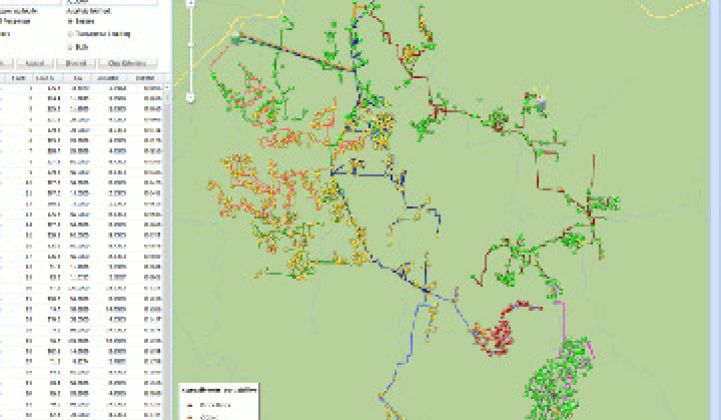Managing a region-wide power grid is a massively complex math problem, involving split-second timing, tons of data and some immutable laws of physics. The tools of the smart grid -- sensors, high-speed communications and control systems -- can help grid operators in that task.
But it’s still hard to know just what’s happening out there at any point in time, without technology to translate real-world data into an accurate and up-to-the-minute model of the grid. That’s the goal of GRIDiant, a startup with a decade of technology development under its belt -- and some brand-new utility clients willing to give it a whirl.
On Tuesday, the Sacramento Municipal Utility District announced it was going to use the Los Altos, Calif.-based startup’s technology to help model its transmission and distribution grid system. Working with New Power Technologies, another startup, SMUD plans to use the tool to figure out just how electric vehicle deployments, energy storage systems, demand response programs, distributed generation, and solar PV generation will affect the grid overall.
Just one day after the SMUD news, Baltimore Gas & Electric announced a joint technology agreement with GRIDiant aimed at commercializing software the two have developed to help predict where fault circuit sensors should be placed on the grid to maximize investment.
Add those new names to a customer list that includes Pepco, Southern California Edison, Silicon Valley Power, the California Energy Commission and Pacific Gas & Electric. Of course, some of those were from the last decade. Originally founded in 2000 under the name Optimal Technologies, the company raised $25 million from Goldman Sachs in 2007, only to disband and transition its key technology to GRIDiant in 2010.
Today, GRIDiant is now working with other partners, including IBM on an unnamed smart grid project, as well as unnamed smart metering and grid sensor vendors, to incorporate their sources of data into its power flow modeling and analytics engines, CEO Andrew Colman said in a phone interview.
“We’re almost a turbo-charger to what’s already out there,” he said. Essentially, GRIDiant builds a model of the distribution grid its customer has targeted for insight. Then it runs power flow analyses through that model, to align it with the laws of physics that determine how electricity flows throughout the system. That in itself isn’t too unusual -- model-based distribution management systems (DMS) are part of the way the industry does business nowadays.
But GRIDiant also layers a set of optimization analytics on top of that model, he said. That allows it to figure out where the grid might not be running to best capacity, or to plot out how new technologies being added to it will affect its performance and reliability.
“There are people who do power flows, people who do models, and people who do analytics. But we’ve kind of tied them all together, both for planning and operations speed,” Colman said. The results, so far, have been primarily for planning purposes, and thus not tied to real-time DMS operations to date, he noted.
But they can still give help to real-time grid operations. One example Colman cites is SCE’s CEC-funded partnership with GRIDiant and New Power Associates, which analyzed transmission and distribution systems for a grid serving about 275,000 customers. That project included lots of sensors and, of course, access to SCE’s Itron smart meter network. But it also filled out many of the gaps that those data sources can’t solve, he said.
For example, power line sensors can tell you with pinpoint accuracy what the voltage on a line is -- but only at the specific point where they’re located. Figuring out the true voltage along all the other, un-sensored parts of the line requires some accurate, self-correcting models, as well as some complex math.
In the case of the SCE project, GRIDiant was able to establish, within 2 percent accuracy, what the voltages were along those other “dark” sections of the line, as verified by actually going out and measuring them, Colman noted. That’s the kind of predictive analysis that could be very useful to volt/VAR optimization (VVO) and conservation voltage reduction (CVR) schemes that reduce line voltages to save power, while needing to stay within boundaries that will make sure the grid isn’t under undue stress.
Analytics can also help fill in the blanks when it comes to costs, Colman added. One of the company’s customers, a sensor manufacturer, has been using GRIDiant’s data to help show utility customers just how many sensors, strategically deployed across certain substations and feeder lines, deliver the biggest bang for the buck.
We’ve seen a number of high-tech startups offering similar grid modeling and analytics capabilities. Battelle-funded Gridquant has developed a new form of mathematics to allow transmission grid modeling to be done faster and with more accuracy, for example. Companies like Versant, GridGlo and AutoGrid are building smart grid applications on top of their unstructured data analytics software platforms built out of the latest developments from the telecommunications and finance IT sectors.
At the same time, IT giants like Oracle, EMC, Microsoft and IBM are promising big data tools to help grid systems and the IT systems that control them get up to the same speed, so to speak. That’s led to a good number of acquisitions in the space, though not specifically grid related. Oracle just bought big-data startup DataRaker, and Teradata, which is working closely with partners like Southern California Edison and Itron on smart meter data management, bought big-data startup Aster Data in 2011.
As for GRIDiant’s funding to date, “Our primary strategy is organic growth through OEM sales and some direct sales to utilities, supplemented by judicious equity fundraising,” Colman said. That includes some unnamed strategic investors, as well as European investors, for an undisclosed amount of funding that Colman characterized as being less than some of the $10 million-plus rounds we’ve seen in the smart grid space to date.



